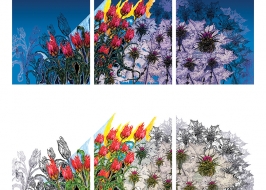Maty Grunberg"Watershed"Ullmann Building of Life Sciences1
The Tulip and the Thorn – a series of prints, in collaboration with Amos Oz and Dr. Michael Avishai
What doesn’t kill you makes you stronger. Coping with deprivation and strain toughens the organism; a life of plenty “pads” and softens it. Young people growing up in tough neighborhoods were once seen as “not nice”: They were rough-edged and prickly, demanding, impatient and obdurate. They were brash in their demands for social justice – for a fair spread of the social burden, on the one hand, and an equal distribution of resources, on the other.
One can see this axiom at work in the area around Jerusalem, which is home to a great many species of plants: The watershed passing through it divides the area into two very different ecological regions. The western slopes of the Jerusalem hills receive a fair amount of rain each winter, and the plants there are fleshy-leafed. One could almost call them complacent. Over the eastern slopes, however, the clouds dissipate before rain can fall; the plants there are desert species: tough and spiny.
The Tulip and the Thorn series, which Maty Grunberg composed with the help of botanist Dr. Michael Avishai, uses native plant species to portray a series of meetings between two cultures: between plenty and want, between softness and toughness, between obsequiousness and rage. The meetings sometimes seem as if they are a mutual groping arising from curiosity. Other times, there seems to be a sort of peace dialog or attempt to find a basis for mutual existence; while yet others appear to depict the beginnings of a struggle that could suddenly turn violent.
The nine encounters in the series – intimate meetings between botanical couples – occur day and night, and thus the series comes in different versions representing different times of day: daylight, twilight, night and dawn. Accompanying the prints are extracts from the book A Tale of Love and Darkness, by Amos Oz.
Maty Grunberg was born in Yugoslavia in Skopje, the capital of Macedonia, in 1943. He immigrated to Israel with his family, who had survived the Holocaust, in 1948. He graduated with honors from Bezalel Academy of Arts and Design in Jerusalem and continued his studies at the Central School of Art and Design, London. He worked as an assistant to many of the best-known Israeli artists: Yaakov Agam, Dani Karavan, Yigal Tumarkin and Menashe Kadishman. From 1969-2007, he lived and worked in London. His works have been exhibited in galleries and museums around the world. He has often collaborated with writers and poets: three of his etchings accompanied the poetry of John Lennon in The Beatles Illustrated Lyrics Number Two. In Israel, he has worked with Yehuda Amichai, Natan Zach, Amos Oz and others. In 2007, Grunberg returned to Israel and opened a studio in Bat Yam, not far from where he grew up. In recent years, his works have included a number of sculptural sundials that are displayed in different sites in Israel and around the world, including the New York Hall of Science and Teddy Park in Jerusalem.
Curator: Yivsam Azgad



